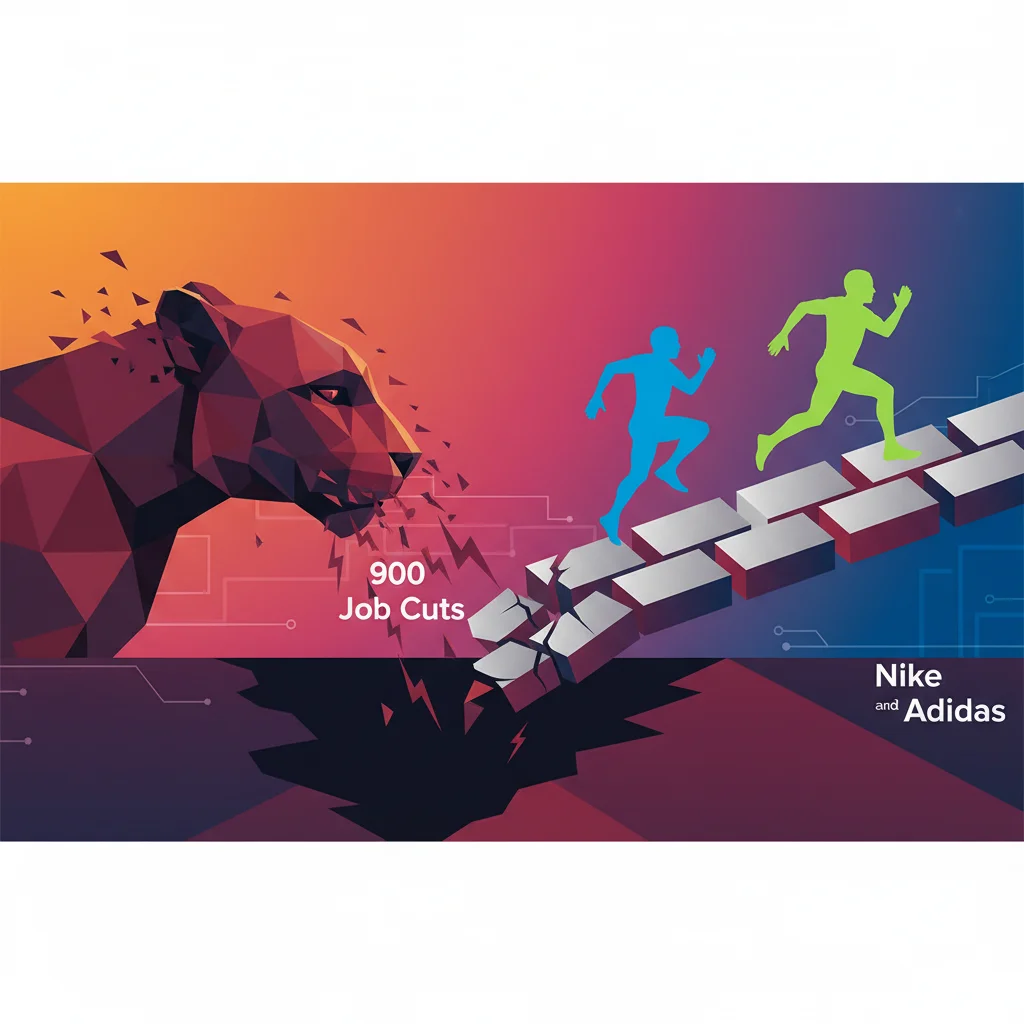
Puma’s Painful Pivot: Can 900 Job Cuts Close the Gap on Nike and Adidas?
In the high-stakes marathon of the global sportswear industry, falling behind is not an option. Puma, the German giant, has just made a move that signals both the urgency of its situation and the resolve of its new leadership. In a decision he described as “painful,” new CEO Arne Freundt announced that Puma will be cutting approximately 900 jobs as part of a sweeping effort to streamline operations and reignite its competitive fire. This isn’t just a routine corporate restructuring; it’s a stark admission that the brand is, in Freundt’s own words, “trailing behind its competition.”
For investors, employees, and industry observers, this move raises critical questions. Is this a necessary evil to ensure long-term survival and growth, or a sign of deeper trouble? As Puma attempts to close the formidable gap with titans Nike and Adidas, this strategic pivot will have profound implications for its financial performance, stock market valuation, and place in the global economy. This analysis will delve into the financial context of Puma’s decision, the competitive landscape it faces, and the potential roadmap for its turnaround.
The Financial Sprint: A Look at the Numbers
A corporate decision of this magnitude is never made in a vacuum. It’s a direct response to financial pressures and market realities. While Puma has seen periods of strong growth, recent performance has highlighted vulnerabilities. The announcement comes on the heels of a challenging financial period where rising costs and shifting consumer behavior have squeezed profit margins across the retail sector. Freundt’s acknowledgement of trailing the competition is not just rhetoric; it’s a reality reflected in key financial metrics.
To understand the scale of the challenge Puma faces, it’s essential to compare it directly with its two main rivals. The following table provides a snapshot of the competitive landscape, illustrating the financial chasm Puma’s new leadership is determined to cross.
| Metric | Puma SE (PUM.DE) | Nike, Inc. (NKE) | Adidas AG (ADS.DE) |
|---|---|---|---|
| Market Capitalization* | ~€8.5 Billion | ~€145 Billion | ~€30 Billion |
| Annual Revenue (2022)* | €8.46 Billion | $46.71 Billion (~€43.5B) | €22.51 Billion |
| Global Brand Value Rank (Apparel 50 2023)** | #17 | #1 | #3 |
*Data is approximate and subject to market fluctuations. **Source: Brand Finance Apparel 50 2023 report.
The numbers tell a clear story. Nike’s market capitalization is over 17 times that of Puma, while Adidas is more than triple its size. This disparity in scale grants Nike and Adidas enormous advantages in marketing spend, R&D, supply chain leverage, and talent acquisition. The job cuts, while painful, are a classic first step in a financial turnaround strategy: reduce operational expenditure to free up capital for reinvestment in areas that can generate growth, such as marketing and product innovation. The immediate goal is to improve profitability and demonstrate to the stock market that management is taking decisive action.
The Bitter Truth: Unwrapping the Complex Economics Behind Your Shrinking Chocolate Bar
The Giants’ Playground: Dissecting the Competitive Disadvantage
Puma’s struggle isn’t due to a lack of quality products, but rather the monumental challenge of competing in a market dominated by two of the world’s most powerful brands. Nike and Adidas have built deep, multi-generational moats around their businesses.
- Nike’s Marketing & Tech Hegemony: Nike is not just a sportswear company; it’s a cultural phenomenon and a technology powerhouse. Its marketing budget is colossal, securing top-tier athletes like LeBron James and Cristiano Ronaldo. Furthermore, its investment in financial technology and digital infrastructure, like the SNKRS app and its direct-to-consumer (DTC) ecosystem, creates a sticky customer relationship that is difficult for competitors to break.
- Adidas’s Lifestyle & Legacy: Adidas masterfully blends performance sportswear with high-fashion and lifestyle appeal (the “athleisure” trend). Despite the costly termination of its Yeezy partnership, its legacy with iconic lines like the Stan Smith and Superstar, combined with a strong foothold in global soccer, gives it a resilient market position.
Puma, by contrast, has often found itself caught in the middle. It has strong products and notable endorsements (like Neymar Jr. and LaMelo Ball), but it lacks the overwhelming marketing presence of Nike or the deep-rooted lifestyle appeal of Adidas. The current global economy, marked by inflation and cautious consumer spending, further exacerbates this issue. When households tighten their belts, they tend to gravitate towards established, top-tier brands, making it harder for challenger brands to gain market share.
Freundt’s Playbook: Charting a Course for a Comeback
Beyond the immediate headlines of job cuts, a new strategic direction for Puma is emerging. This restructuring is the foundation upon which a leaner, more agile company can be built. Based on standard corporate turnaround strategies and the current market dynamics, Freundt’s playbook will likely focus on three core pillars.
Here is a breakdown of the likely strategic priorities for Puma’s leadership:
| Strategic Pillar | Key Objectives & Actions |
|---|---|
| 1. Cost Optimization & Efficiency | – Execute the announced 900 job cuts to reduce overhead. – Streamline supply chains and leverage technology for better inventory management. – Re-evaluate non-core business activities and sponsorships for ROI. |
| 2. Brand Elevation & Focus | – Increase marketing spend in targeted, high-impact campaigns. – Focus on “brand heat” through authentic cultural collaborations and key influencers. – Double down on growth categories like basketball and performance running to build credibility. |
| 3. Strategic Market Penetration | – Prioritize investment in key growth markets like North America and China. – Enhance the direct-to-consumer (DTC) channel, improving online shopping experiences and leveraging data. – Strengthen relationships with key wholesale partners to ensure premium product placement. |
Success will hinge on execution. For example, enhancing the DTC channel requires significant investment in e-commerce platforms, data analytics, and the kind of seamless financial technology and banking integrations that customers now expect. This is a crucial area of the modern retail economy where Puma cannot afford to lag.
The £260m Paradox: Why UK Water Customers Are Getting a Refund While Bills Are Set to Soar
The Investor Perspective: Trading on a Turnaround Story
For those involved in finance and investing, Puma’s situation presents a classic turnaround case study. The stock market’s reaction to such news is often complex. Initially, news of cost-cutting can be viewed positively, as it signals a focus on profitability. However, it also confirms the company’s underlying struggles, which can create downward pressure. The key for investors is to look beyond the headlines and analyze the long-term potential.
Key performance indicators (KPIs) to monitor in the coming quarters will be:
- Gross Profit Margins: Are the cost savings translating into improved profitability?
- Revenue Growth in Key Markets: Is the strategy to focus on North America and China yielding results?
- Direct-to-Consumer (DTC) Sales Percentage: Is Puma successfully reducing its reliance on wholesale and building direct customer relationships?
- Inventory Levels: A key indicator of operational efficiency and demand forecasting.
The broader economics of the consumer discretionary sector also play a crucial role. Central banking policies on interest rates directly impact consumer borrowing and spending power. A challenging macroeconomic environment could be a significant headwind for Puma’s recovery, regardless of how well its strategy is executed. Therefore, any investment thesis in Puma must balance the company-specific turnaround efforts with a realistic assessment of the global economic outlook.
Conclusion: The Race is Far From Over
Puma is at a pivotal moment. The decision to cut 900 jobs is a difficult but decisive first step under its new CEO to address the competitive gap with Nike and Adidas. This move is less about shrinking the company and more about reallocating resources to fight more effectively. By focusing on financial discipline, brand elevation, and strategic market growth, Puma aims to transform itself from a distant third into a more formidable contender.
The path forward is fraught with challenges, from intense competition to macroeconomic uncertainty. However, for a brand with a rich history and global recognition, the opportunity for a powerful resurgence remains. The coming 18-24 months will be a critical test of Arne Freundt’s leadership and the resilience of the Puma brand. For the world of finance, business, and investing, Puma’s journey will be a compelling story to watch—a story of whether a painful pivot can truly change the pace of the race.


